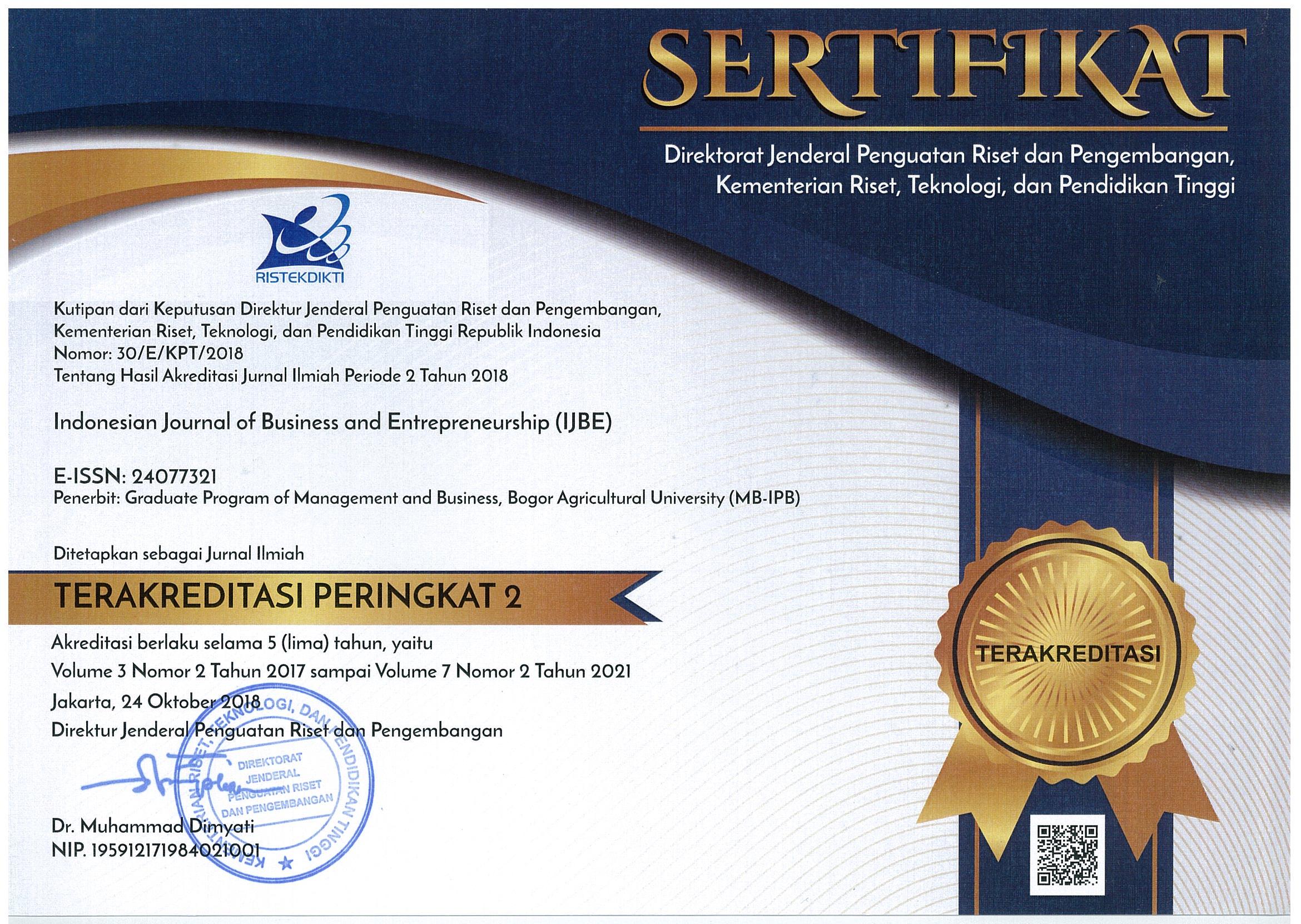Correspondence Analysis of Indonesian Retail Banking Personal Loans Top Up
Abstract
Customer experience can be developed through good database management, and this is an important thing to do in the era of tough retail banking competition especially in the personal loan market competition. Through good database management, banks can understand the transaction pattern and customer behavior in each bank service’s contact point. This research aimed at identifying the personal loans correspondence between socioeconomic variables and top up transaction by using the secondary data from one of Indonesian retail banking. The research method used the correspondence analysis and regression. The result of the research showed that the socioeconomic factors that influenced the debtors to top up personal loans at the confidence level of 5% (0.05) included Age, Marital Status, Dependent Number, Living Status, Education, Region, Job Type, Work Length, Salary, Debt Burdened Ratio (DBR), Credit Tenure, and Credit Limit, and only Gender had no effect on personal loan top up. The socioeconomic factors that were close correspondence with the personal loan top up transactions included bachelor degree, State-Owned Enterprises and goverment civil servant employee, income starting from Rp 5 million, credit period starting from 4 years, dan credit limit starting from Rp 50 million. The findings in this study are expected to be useful for marketers of the banks in developing personal loan products and also in preparing a more targeted marketing strategy so that it becomes more effective and efficient for the banks. In addition, the expected implication is that the customer experience will be better because the product developed will be more customer centric.
Keywords: bank, correspondence analysis, personal loans, regression, top up
Downloads
References
Aviliani, Sumarwan U, Sugema I, Saefuddin A. 2011. Segmentasi nasabah tabungan mikro berdasarkan recency, frequency, dan monetary: Kasus Bank BRI. Finance and Banking Journal 13(1):95–109.
Backiel A, Baesens B, Claeskens G. 2016. Predicting time-to-churn of prepaid mobile telephone customers using social network analysis. Journal of the Operational Research Society 67(0):1–19.https://doi.org/10.1057/jors.2016.8.
[BBRI] Bank BRI. 2016. Financial Update 1H 2016. Jakarta: Investor Relations PT Bank BRI (Persero) Tbk.
[BI] Bank Indonesia. 2007. Risk Based Capital: Dari Basel I Menuju Basel II. Jakarta: Direktorat Penelitian dan Pengaturan Perbankan BI.
[BI] Bank Indonesia. 2016. Survei Perbankan Triwulan IV-2016. Jakarta: Divisi Statistik Sektor Riil BI.
[BMRI] Bank Mandiri. 2016. Analyst Meeting 1H 2016. Jakarta: Investor Relations PT Bank Mandiri (Persero) Tbk.
Cheng CH, Chen YS. 2009. Classifying the segmentation of customer value via RFM model and RS theory. Expert Systems with Applications 36 (3 part 1): 4176–4184.https://doi.org/10.1016/j.eswa.2008.04.003.
Gouws N. 2012. Identifying factors that influence customer retention in a South African Retail Bank [disertasi]. South Africa: SA Vertalersinstituut.
Irmariani R. 2013. Analisis customer relationship management (CRM) pada BPR Supra Bogor [tesis]. Bogor: Institut Pertanian Bogor.
Kleinbaum DG, Klein M. 2005. Statistics for Biology and Health. New York: Springer Science + Business Media, Inc.
Kotler P. 2005. Manajemen Pemasaran. Edisi Bahasa Indonesia. Jakarta: PT Indeks Kelompok Gramedia.
[OJK] Otoritas Jasa Keuangan. 2016. Statistik perbankan Indonesia tahun 2016 Volume 14. Jakarta: Departemen Perizinan dan Informasi Perbankan.
Sanjaya R, Sumarwan U, Kirbrandoko. 2015. Hubungan customer relationship management dengan loyalitas nasabah (studi kasus: PT Bank XYZ cabang Bogor). Jurnal Manajemen Pengembangan Industri Kecil Menengah 10(2):151–162.
Setiawan I, Suharjo B, Najib M. 2016. Effect of mix marketing on re-purchase decision of muslim dress in Bogor (muslim clothing product of keke). Indonesian Journal of Business and Enterpreneurship 2(3):197–207. http://dx.doi.org/10.17358/ijbe.2.3.197.
Sumarwan U. 2016. Pemasaran Strategik: Perspektif Perilaku Konsumen dan Marketing Plan. Bogor: PT Penerbit IPB Press.
Surodjo B. 2016. Banking Journalist Academy Consumer Banking [presentasi]. Jakarta: PT Bank Permata.
Zeithaml V, Bitner MJ, Gremler D. 2013. Services Marketing: Integrating Customer Focus Across The Firm. New York: The McGraw-Hill Companies, Inc.
Zineldin M. 2005. Quality and customer relationship management (crm) as competitive strategy in the swedish banking industry. The TQM Journal 17(4):329–344. https://doi.org/10.1108/09544780310487749.







